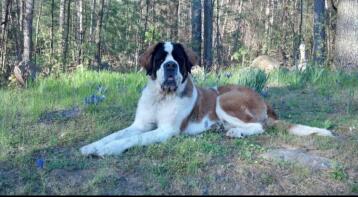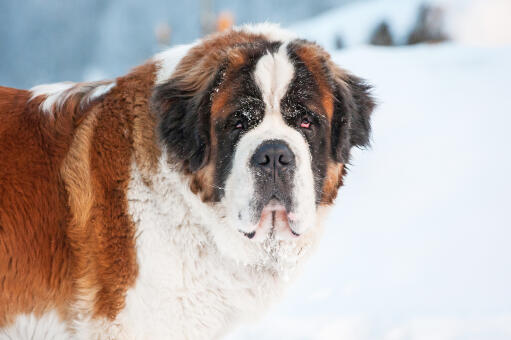Sankt Bernards hund





History
The earliest records of Saint Bernards date back to 1707 from the Monks of Saint Bernard Pass Hospice between Switzerland and Italy. The breed probably originated from Roman Molossian dogs, but soon became renowned for it's life saving abilities. They were used for to help pull carts and turn spits, but the monks soon realised they they had a built in ability to find paths through deep snow and find lost travellers. Interestingly, the monks didn't train the dogs in rescue techniques, younger dogs simply learnt from the older ones.
Behaviour
Saint Bernards are devoted to their family and excellent with children. They seem to know how children act and treat them carefully and respectfully, even moving out of the way to avoid knocking them over. They are very gentle, patient dogs who are very playful and hyper as puppies, but placid and calm adults. As with all large breeds, training should be started young and be consistent. They aren't the easiest breed to train and can be stubborn, but do learn and need to keep their brains active. Training should be assertive to prevent the dog taking over. These are friendly dogs, if well socialised but if not can cause problems. They are usually fine with other dogs and pets if introduced early on. They need daily walks, more to keep their minds alert, more than their bodies; they can be quite lazy and will often not want to go out. Preferring to sleep on your sofa or bed. They are not at all aggressive, but their size alone is usually enough to deter intruders. They make a good watch dog and will bark when strangers approach. They are protective of their family and can sometimes become overly protective, so that needs to be watched. A tall fence is recommended to avoid escapees.
Their coat can get quite long and they do require a fair amount of grooming, brushing at least 3 times a week. Saint Bernards can overheat quite quickly in the summer, so need somewhere cooler to sleep during the day. They do drool, a lot and continuously. Health wise, they can be affected by Canine Hip Dysplasia. Due to their very fast growth rate, it is important to feed a balanced quality feed when they are growing up to prevent problems down the line.
Temperament
Saint Bernards have a steadfast and easygoing temperament. These are very large, powerful dogs who are patient and loving of their family. They tend to have a lazy side and owners must encourage them to get their daily exercise in to stay fit and healthy. Saint Bernards love companionship and will often lean against you or sit on your feet. Generally they are chilled out in terms of meeting new people or other dogs but don't expect them to be particularly playful.
Health Problems
Health problems that may affect Saint Bernards include canine hip dysplasia (CHD), elbow dysplasia, luxating patella (dislocation of the knee cap), other orthopedic disease, epilepsy, bloat, cancer, allergies, blood clotting disease and eye problems.
Breed Details
- Status: Common
- Life Expectancy: 8 - 10 years
- Vægt: 64 - 120 kg
- Højde: 28 - 35"
- Rare: Nej
- Coat: Lavt
- Grooming Requirements: More than once per week
- Town or Country: Either
- Minimum Home Size: Large House
- Minimum Garden Size: Small to Medium Garden
- Breed Type: Working Dog
- Størrelse: Giant
- Energy Level: Lav
- Exercise Required: Up to 1 hour
Billeder af Saint Bernard










